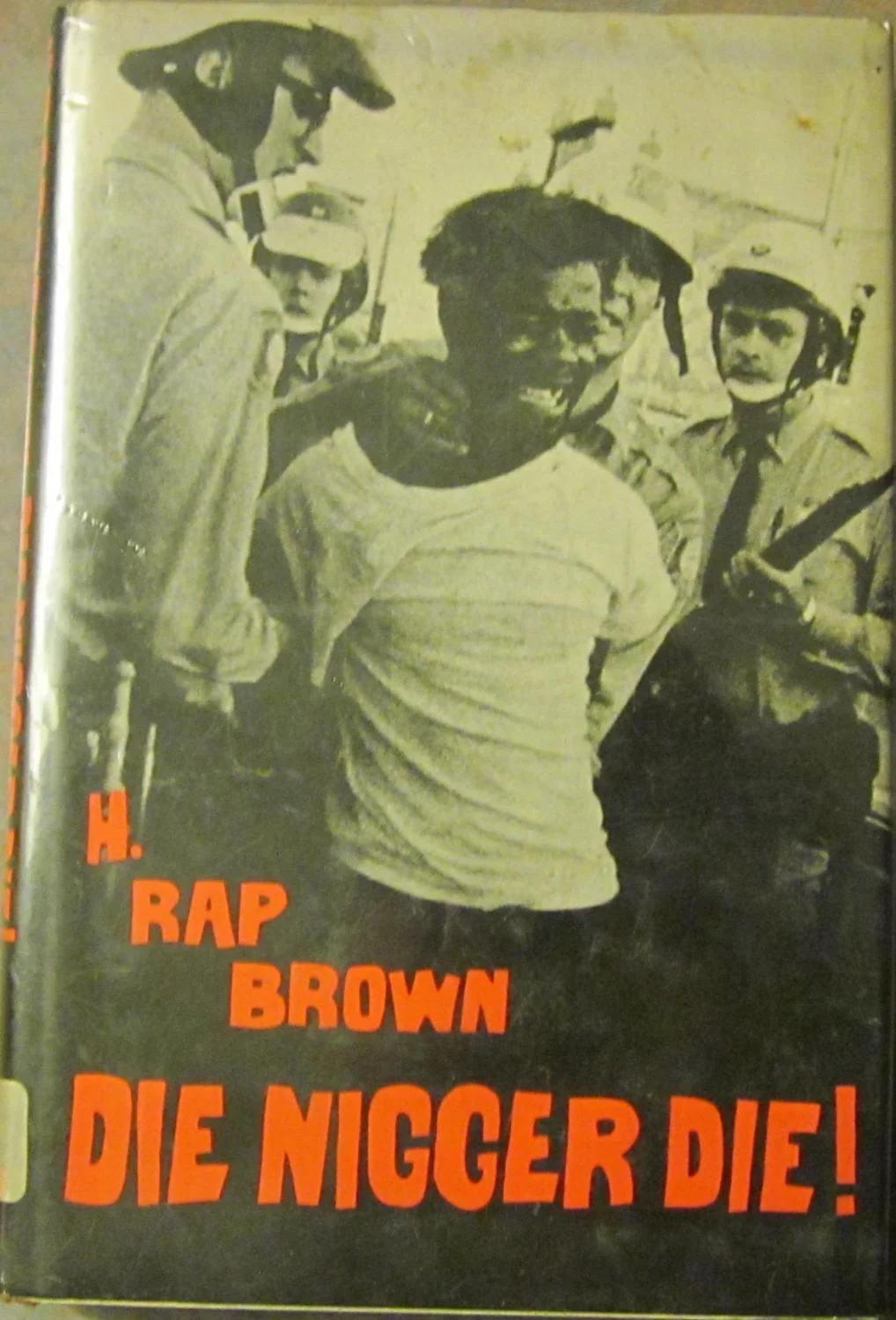H. Rap Brown
Notes on H. Rap Brown.
BY TONY WOLK
These notes are provided as annotations to Wolk’s 1972 interview with James Baldwin.
H. Rap Brown (1943-): Born Hubert Gerold Brown in Baton Rouge, October 4, 1943, the fifth chairman of the Student Nonviolent Coordinating Committee (SNCC), Brown is obviously a key figure in the Black Power Movement. He is the author of Die Nigger Die (The Dial Press, 1969), a vital Portrait of a Political Artist as a Young Man. I choose “young,” given that the Rap Brown from the nineteen-sixties is alive at the age of seventy-six, though unwell. He has been living in prisons (presently a federal maximum security penitentiary) since March of 2002. Fortunately, I hope, there may be some light at the end of this dismal tunnel.
Die Nigger Die is a fascinating story, whereas the story his life is ultimately horrific.
In 1967, a secret FBI memo calls for “neutralizing” Brown. In the late 1960s he was charged with inciting to riot (charges which were proven false by the Kerner Commission, 1968). He was taken to Cambridge, Maryland, to be tried. He was defended by William Kunstler, Howard Moore, Jr. (a general council for SNCC), and Murphy Bell of Baton Rouge.
Brown was initially to be tried in Cambridge, Maryland. Then followed an unsolved bombing of the Cambridge courthouse where Brown was to be tried—this after the deaths of two SNCC officials (Ralph Featherstone and William [“Che”] Payne) on U. S. Route 1 when a bomb exploded on the front floorboard of their car. The next night the courthouse was bombed. The source of the first bomb is disputed: was it a successful assassination of Payne and Featherstone; or was it an accident, and their plan had been to bomb the courthouse? The obvious question: one bombing yet two bombs?
In February of 1968, following the bombing of the Cambridge courthouse, Brown’s trial was moved to New Orleans, the new bond set at $50,000. Then, during a recess at the hearing, an FBI agent, a Negro (in the words of Brown) “come walking up to me. The dude has testified against me in court, saying he had heard me speak out in California so I recognized him. Before he could get a word out of his mouth, I said to him, ‘I hope your children don’t grow up to be a Tom like you are.’ I get back in court and I see this traitor on the stand telling the judge that I’d threatened his life. So the judge charged me with threatening a FBI agent and set the bail at $50,000 from that charge. So now I had $100,000 bond on me.” Ultimately, Brown went on a hunger strike and wrote his second letter from jail, which begins, "Being a man is the continuing battle of one’s life and one loses a bit of manhood with every stale compromise to the authority of any power in which one does not believe.” [Die Nigger Die, 114]
After posting bond, Brown disappeared for eighteen months. He was now on J. Edgar Hoover’s “10 Most Wanted List.” Brown would then be arrested for what was reported as an attempted robbery of a bar in New York City, and spend five years in prison (1971-1976). By the time of my interview with Baldwin (April, 1972), Brown was in prison. While in prison, Brown converted to Islam and changed his name to Jamil Abdullah al-Amin. After his release, he opened a grocery story in Atlanta, Georgia, and becomes a Muslim spiritual leader and a community activist.
Georgia, March of 2000: Al-Amin is arrested for speeding, then for impersonating a police officer (he may have had the badge of an honorary police officer from a town in Alabama). What followed was the shooting of two deputies, one of whom died. Al-Amin was charged with murder, though the testimony against him was suspect. Two of his guns were found in the woods, all fingerprints on the guns wiped clean. (Why would he remove the fingerprints but leave the guns?!). Al-Amin’s car was riddled with bullets, but al-Amin himself was not wounded! On March 9, 2002, al-Amin was convicted on thirteen charges, including murder, and sentenced to life in prison without possibility of parole. He is sent to Georgia State Prison.
Yet shortly after the shooting a man named Otis Jackson confessed to the shooting and was convicted of the same crime; yet Jackson’s evidence was not considered by the court, despite explicit evidence from the same firefight. Ultimately, al-Amin was considered too high profile for a state prison and so was transferred to the United States Penitentiary Administrative Maximum Facility near Florence, Colorado. Then in 2014, after a diagnosis of multiple myeloma, he was transferred to Butner Medical Center in North Carolina. As of March, 2018, he is incarcerated at the U. S. Penitentiary in Tucson.
Currently (this being the light at the end of the tunnel), there is the possibility of a retrial through the 11th Circuit Court of Appeals, following the confession of Otis Jackson. As of May, 2019, he is still in prison.
Now for several quotes from his Die Nigger Die (The Dial Press, 1969):
Here was that question of authority again. If authority is to be used, it should not be a coercive type thing. After all, what dictates that a person can be put in an authoritative position over someone else? If it's experience, then respect should come from that, not authority. People should adhere to rules because they respect them and not because some position mandates that respect. Now if you raise a legitimate issue with a person and they respect it, then they're gonna adhere to it. It's like the principle of self-determination. But when you're in a certain position and you tell a cat to do something with no grounds for it, it provokes a type of rebellious behavior. [48-49]
and
When the people cannot find a redress of their grievances within a system, they have no choice but to destroy the system which is responsible in the first place for their grievances. The government is the lawbreaker. The people must become the law enforcer. We cannot allow the government to be an outlaw, particularly when the crime is against the people. [63]
and
If sanity is dropping bombs on humans, then thank goodness for insanity. [74]
and
I preach a response to violence. Meet violence with violence. [85]
Chapter 10 ends with prophecy:
I anticipate one day, however, that I will be arrested and there will be no legal procedure any lawyer will be able to use to secure my release. In fact the question will not be, Let’s get Rap out of jail. It’ll be, Where is Rap? [108]






